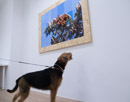Sergey Bratkov - La queue remue le chien
Sergey Bratkov was born in Kharkiv, Ukraine in 1960. From 1969 through 1978 he attended the Repin Art College in Kharkiv. In 1983, he graduated from the department of Industrial Electronics at the Polytechnic Academy in Kharkiv to complete the typical Soviet education. In 1987, Bratkov’s had his first solo shows in Kharkiv, Cheb, and Tel Aviv. In the following years, he enjoyed international recognition from his solo exhibitions at the Forum Stadtpark Graz, in Berlin, Nuremberg, Wisconsin, and Triest. He also took part in smaller and larger post-Soviet group exhibitions in Finland and New York, international art fairs, the Sao Paulo Biennale 2002, the Moscow Photobiennale, and recently at the Venice Biennale 2003 [Russian Pavilion] and 2007 [Ukrainian Pavilion].
Photography in Russia and Ukraine had to be restructured after the end of the socialist system. It was able to find its place in the field of art following Western standards, with new tendencies regarding form and content which quickly surpassed painting in terms of modernity.
The nineties were marked by this radical change. On the one hand, one was looking back to the constructivism of Rodchenko and on the other hand, forms of staged photography emerged, reaching as far as tableaux vivants and staged landscape photography, documentary photography and action photography. In addition artists experimented with modifying their photos into ironical and cynical images via “photoshop”. In Moscow many important artists started the new era of photography with the Group AES+F, Efimov, Group Fenso, Infante father and son, Liberman, Kulik, Mukhin and so on.
There was a special development in Kharkiv in the Ukraine, where in the late sixties, photographer had established themselves in underground art in some sort of radical realism. Members of the Vremia group not only transformed “permitted” topics like architecture and labour but also handled the taboo theme of male nakedness. The resistant, taboo breaking “Fast Reaction Group” with Bratkov, Michailov and Solonski grew up out of this.
The work of Bratkov is very much influenced by his Kharkiv origin. For many years he worked with Boris Mikhailov, who was older and had already developed his style of radical realism during his underground years in the Vremia group, and he learned to name things without taboo and pallation. In Kharkiv, a big Russian Ukrainian industrial town, the photogenic misery is to be found everywhere in the streets: homeless children, casuals, prostitutes, frozen corpses, drunkards, rightwing radical hooligans, wretched old women. The experience of social realism is essential. In its context the portrait is of special value, in its trascendent, stereotype form. Whether it showed party secretaries, workers, peasants, space travellers, scholars or soldiers, they were all typified as heroes. This way of crude standardization is also well known from the art of National Socialism.
Bratkov must be considered in the Soviet and post-Soviet context. After the collapse of the Soviet Union, Russian and Ukranian photography reconstructed itself according to the Western tradition. It managed, however, to maintain a unique identity due to its original form and content.
Fragments of a text by Victor Misiano
Curator and critic, lives in Moscow:
‘Bratkov belongs to the generation for whom the rhetoric of the “happy soviet childhood” appeared to be the statement of an indubitable fact. Yet his personal development led on the way of liberation from the ideological fiction.
It’s essential for the understanding of Bratkov’s work that his childhood and a big part of his life took place in Kharkiv, a huge industrial town, where the hard reality clearly refutes the ideological idyll of the mighty. Probably therefore documentarism became the basis of work for the Kharkiv artists. ... It was also in Kharkiv that Sergey Bratkov, who had started his artistic career as a painter, turned photographer. It is symptomatic that the first and till now unmatched, naturally autobiographic novel of Eduard Limonov, who has his roots in Kharkiv, is called “The Teenager Savenkov ”(in English: “Memoir of a Russian Punk”. Savenkov is the original family name of Limonov).
...In the post soviet nineties the ideological order changed into a society of show, and the propaganda clichés turned into media clichés. If formerly the sphere of human traumas and wishes was reduced to the absence of the mighty and the display of this sphere (…) had a disclosing and liberating character, the situation has changed today. The sphere of traumas and wishes is not any more only part of the world of the subjectivity but also of that of the commercial picture industry (…). Bratkov states the actual, new, post ideological meaning of subjectivity. While there had been obligatory rites for objective acts in the soviet era and an alternative world of subjectivity existed beside it, today the world of subjectivity and the world of cliché images become identical inside and outside. Subjectivity is an industrial product today.
To state this fact led Bratkov to the following conclusion: in the world of the total show and representation through play acting, not only the artwork is settled but even human existence itself (…). Bratkov, like his old friend and colleague Boris Mikhailov, becomes a personage in his own photographs (…).
...Bratkov (…) does not claim his nonparticipation in the general show. In art exhibitions he shows the very same photos he created for e.g. fashion agencies. Both constitute one territory of modern art – there does not exist a sphere of salvation any more like in the soviet period, and art is part of industry as everything else. In the result, Bratkov meets a double problem: the ethical one, to take part in the exploitation of (human beings), and the moral one, to exhibit documents of human humiliation (...).
The ethical blamelessness of Bratkov’s (...) works is apparently derived from their ethical relentlessness. They show that today it is more ethical to acknowledge one’s deep involvement into the amoral order of things than to pretend that distancing oneself is possible.’















